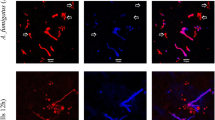Abstract
Inhalation of resting conidia is usually the first step of a systemic infection caused by the opportunistic fungal pathogen Aspergillus fumigatus. In the lung, the inhaled spores encounter an environment that permits germination. However, the relative importance of certain environmental conditions for conidial activation and subsequent hyphae formation has so far not been analyzed in detail. In this study, we studied the role of oxygen during germination. We found that inhibitors of the respiratory chain were nearly as efficient in blocking germination as cycloheximide, an inhibitor of protein synthesis, which is already known to prevent germination of Aspergillus nidulans. We also found that A. fumigatus is unable to grow or germinate under anaerobic conditions, and using the fluorescent mitotracker dye we detected active mitochondria already at the stage of swollen conidia, which indicates that respiration is an early event during germination. In line with these data, we found that significant oxygen consumption was detectable early during germination, whereas no oxygen consumption was measurable in suspensions of resting conidia. In summary, the present study provides evidence that respiration is absolutely required for the germination of A. fumigatus conidia.




Similar content being viewed by others
Literature Cited
Brambl R (1975) Characteristics of developing mitochondrial genetics and respiratory functions in germinating fungal spores. Biochim Biophys Acta 396:175–186
Stade S, Brambl R (1981) Mitochondrial biogenesis during fungal spore germination: Respiration and cytochrome c oxidase in Neurospora crassa. J Bacteriol 147:757–767
Carlile MJ, Watkinson SC, Gooday GW (2001) The fungi, 2nd ed. Elsevier Academic Press, London
Takasaki K, Shoun H, Yamaguchi M, Takeo K, Nakamura A, Hoshino T, Takaya N (2004) Fungal ammonia fermentation, a novel metabolic mechanism that couples the dissimilatory and assimilatory pathways of both nitrate and ethanol. Role of acetyl CoA synthetase in anaerobic ATP synthesis. J Biol Chem 279:12414–12420
Hearn VM, Mackenzie DW (1980) Mycelial antigens from two strains of Aspergillus fumigatus: An analysis by two-dimensional immunoelectrophoresis. Mykosen 23:549–562
Pontecorvo G, Roper JA, Hemmons LM, MacDonald KD, Bufton AW (1953) The genetics of Aspergillus nidulans. Adv Genet 5:141–238
Osherov N, May G (2000) Conidial germination in Aspergillus nidulans requires RAS signaling and protein synthesis. Genetics 155:647–656
Schrettl M, Bignell E, Kragl C, Joechl C, Rogers T, Arst HN Jr, Haynes K, Haas H (2004) Siderophore biosynthesis but not reductive iron assimilation is essential for Aspergillus fumigatus virulence. J Exp Med 200:1213–1219
Valle BL (1960) Metal and enzyme interaction: Correlation of composition, function, and structures. In: Boyer PD, Lardy H, Myrback K (eds) The enzymes, vol. 3. New York: Academic Press, New York, pp 225–276
Osherov N, May GS (2001) The molecular mechanisms of conidial germination. FEMS Microbiol Lett 199:153–160
Paris S, Debeaupuis JP, Crameri R, Carey M, Charles F, Prevost MC, Schmitt C, Philippe B, Latge JP (2003) Conidial hydrophobins of Aspergillus fumigatus. Appl Environ Microbiol 69:1581–1588
Tronchin G, Bouchara JP, Ferron M, Larcher G, Chabasse D (1995) Cell surface properties of Aspergillus fumigatus conidia: Correlation between adherence, agglutination, and rearrangements of the cell wall. Can J Microbiol 41:714–721
Rohde M, Schwienbacher M, Nikolaus T, Heesemann J, Ebel F (2002) Detection of early phase specific surface appendages during germination of Aspergillus fumigatus conidia. FEMS Microbiol Lett 206:99–10
Luther K, Torosantucci A, Brakhage AA, Heesemann J, Ebel F (2006) Phagocytosis of Aspergillus fumigatus conidia by murine macrophages involves recognition by the Dectin-1 beta-glucan receptor and Toll-like receptor 2. Cell Microbiol 9:368–381
d’Enfert C (1997) Fungal spore germination: Insights from the molecular genetics of Aspergillus nidulans and Neurospora crassa. Fungal Genet Biol 21:163–172
Acknowledgments
We thank Kirsten Niebuhr for critical reading of the manuscript. This work was supported by a grant of the Deutsche Forschungsgemeinschaft through SFB 576 to J.H.
Author information
Authors and Affiliations
Corresponding author
Additional information
Anela Taubitz and Bettina Bauer contributed equally.
Rights and permissions
About this article
Cite this article
Taubitz, A., Bauer, B., Heesemann, J. et al. Role of Respiration in the Germination Process of the Pathogenic Mold Aspergillus fumigatus . Curr Microbiol 54, 354–360 (2007). https://doi.org/10.1007/s00284-006-0413-y
Received:
Accepted:
Published:
Issue Date:
DOI: https://doi.org/10.1007/s00284-006-0413-y




